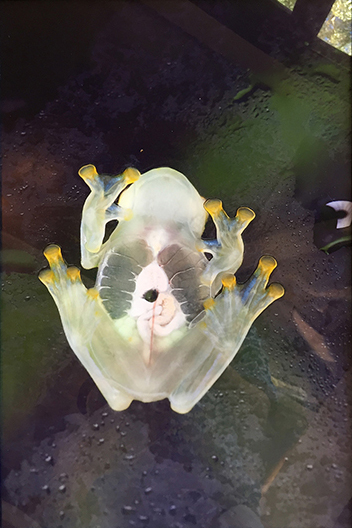Art on Campus - Julia Paull
CAPS SMALL ART COLLECTION
JULIA PAULL

Mother Nature's Son: Glass Frog, Costa Rica, 2017-2018
Julia Paull
Archival Inkjet Print
17 x 11 inches
Location: Science Building, First Floor
Julia Paull is concerned with physical manifestations of existence as experienced bodily and, often, psychologically. Her photographs examine the processes of growth and death in people, plants, and animals. Mother Nature's Son consists of photographs of critically endangered frogs in captive breeding programs at the Costa Rican Amphibian Research Center (Guayacan, Costa Rica), the Amphibian Rescue and Conservation Center (El Valle, Panama), Wikiri Living Forest (Quito, Ecuador), and the San Diego Zoo. Fascinated by the complexity of human gestures such as how one person saves the life of an endangered species while another seeks to destroy it, the artist photographed endangered species in captive breeding programs to look at challenging issues of how scientists artificially sustain life and save species in compromised habitats. The artist was particularly interested in species many might not have the opportunity to see before they become extinct. We continually hear extinction is inevitable for many species, without a sense of how to stop it. Extinction is an abstraction when we’ve never seen the species that ceased to exist but rather experience the unraveling occurring through over population, floods, fires, epidemics, oil spills and summer in winter. When a species dies off, few experience the palpable pain of extinction like the person recording the date, time of discovery, and location of death for the last known sample of the now extinct species. As Joseph R Mendelson, Curator of Herpetology at Zoo Atlanta wrote,“Losing any species to extinction as a result of human activities is a devastating blow to the planet. It is perhaps the most egregious expression of human arrogance – that we deserve to live here and something else does not. I am still struggling to find words to describe how it feels to lose a species to extinction – especially those that I personally discovered and named. Though my career is built on my abilities to find things, I have not found the language to describe this loss.” Amphibians are considered the gateway species to extinction as they have the highest rate of extinction amongst all species. As a result of their sensitivity to environmental changes, vanishing amphibians are considered ‘a canary in the global coal mine’ signaling subtle yet radical changes in ecosystems that ultimately may claim many other species, including humans. Nature is more often than not, running out of nature. Endangered species will continue to exist only with much greater acts of love, one of which is to plant native plants in appropriate habitats thereby providing food for native species. Another is to care for and help procreate species in danger of extinction.
A native Southern Californian, Julia received her MFA in Photography at the California Institute of the Arts and her BA in Art Studio from University of California, Santa Barbara. She is an Associate Professor of the Practice of Art at the University of Southern California, Roski School of Art and Design.

Stay Connected